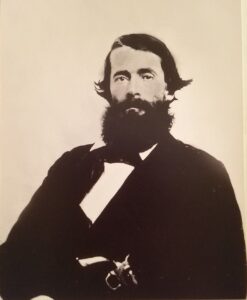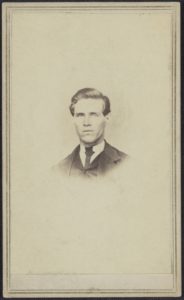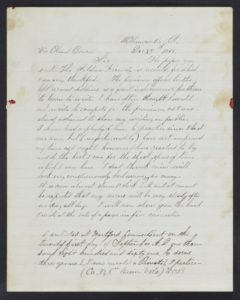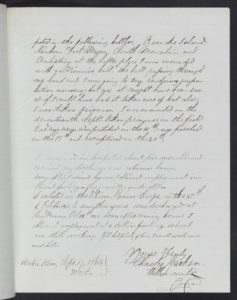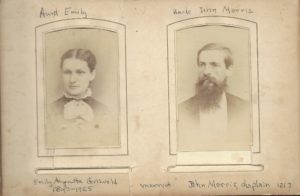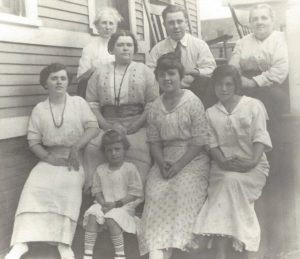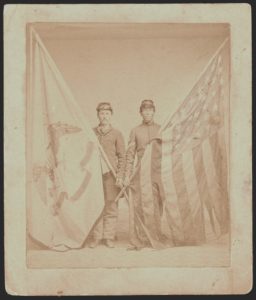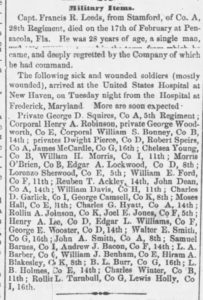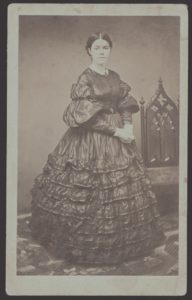William T Gregory (c. 1862)
14 June 2024
As a member of Florida’s Secession Convention of January 1861, wealthy planter William Thomas Gregory voted against leaving the Union, but about a year later he enrolled as a Captain in the 5th Florida Infantry for Confederate Service. He gave his life to that cause, being mortally wounded at Sharpsburg on 17 September 1862.
Great-great-great-grandson Russell Suber kindly sent me a copy of his fine photograph of a fierce looking Captain Gregory.
Charles Jackson’s left-hand penmanship
27 May 2024
Charles Jackson, a Private in the 8th Connecticut Infantry was not quite 18 years old when he was shot through the right wrist at Antietam on 17 September 1862 and captured there at the farthest advance of the Union Ninth Corps that day, nearly to the town of Sharpsburg.
The next day his hand was amputated at the forearm, probably by a Confederate surgeon. Two days later, left behind near the battlefield when the Confederate Army retired to Virginia, he was “recaptured” and put in the care of his own Army. He was sent home in February 1863 but returned that fall and served two more years, in the Veteran Reserve Corps, to October 1865.
Which is probably when he saw an announcement like this one:
On Christmas Day 1865 he wrote the organizer of the event, the Rev. W. Oland Bourne, describing his war experience, his wounding at Antietam, and his life at that moment and enclosing a sample of his best handwriting as his entry in the contest. He was the 221st of some 270 men to enter.
He did not win any prizes, but certainly made a respectable showing.
Just 21 years old at the time of the contest, Charles went on to a long and fruitful life, and was a letter carrier in Hartford for almost 50 years.
Notes
See much more about the penmanship contest and it’s sponsor, William Oland Bourne, in an exhaustive exhibit at the Library of Congress, source of the photograph and documents here; transcriptions below.
At least 13 other amputee survivors of the Maryland Campaign of 1862 also entered the 1865-66 contest (Series 1) or the one that followed in 1867 (Series 2); viz:
Capt. Charles A. Edmonds, Co. H, 7th Michigan Infantry, South Mountain, MD (9/14/1862); Ser. 1, #51 …
#22,000
26 May 2024
The Antietam on the Web database is now up to 22,000 individuals.
The entry getting us to that number is for the man under this impressive stone in Colchester, CT: Henry A Ransom, late Corporal, 8th Connecticut Infantry. He was seriously wounded in the knee at Antietam in September 1862 and troubled by it for the remaining 20 years of his life.
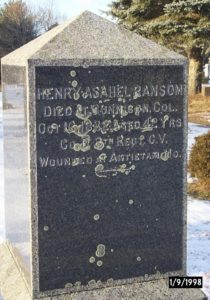
[photo by the late Frank Grimes for Find-a-grave]
Onward!
Lt. Jacob Eaton (1862)
15 May 2024
The Reverend Jacob Eaton was a Congregational minister in Meriden, CT before the war and enlisted in the 8th Connecticut Infantry as a Private soldier in September 1861. He was appointed First Lieutenant in February 1862 – and probably sat for this photograph soon after.
He was wounded in the leg at Antietam in September 1862 and resigned his commission in October, but returned to the field as the Chaplain of the 7th Connecticut Infantry in 1864. He died of disease in Wilmington, NC in March 1865.
This fine photograph is in the collection of the Connecticut Museum of Culture and History in Hartford.
Emily A Griswold and John M Morris (c. 1863)
14 May 2024
Emily Griswold and John Morris were probably engaged before he left New Haven for service as Chaplain with the 8th Connecticut Infantry in April 1862 and they married in December 1863, about three months after he returned home.
Emily was from a large and prominent Connecticut family, her father a successful farmer at Wethersfield, near Hartford.
Here she is in her wedding dress:
I think it’s safe to say her husband was not the same man she knew in New Haven in the Spring of 1862, fresh out of Yale Divinity School.
At Antietam, in particular, he’d been through some harrowing combat. He was with his regiment out in front of the Federal Ninth Army Corps in the advance above the Rohrbach (later Burnside) Bridge, nearly reaching the town of Sharpsburg by about 5 pm on 17 September 1862. Earlier in the day he assumed the typical Chaplain’s role of assisting wounded men to the rear, but by the end he’s picked up a rifle and “fights for life” himself.
Sadly, Emily became a young widow in 1873 when John died of tuberculosis at age 36.
Notes
These photographs are from the Cabinet Card Album of Mary Helena Griswold, wife of John Leslie Welles, now held by the Welles Family Association, Wethersfield; shared to the FamilySearch genealogical database by Barbara Mathews.
Antietam Burnside Mann (c. 1915)
9 May 2024
Peter Mann married in his native Scotland in 1831, came to America in the next year or two, and had 10 children with his wife Isabella before she died in 1855. He married again, in 1857, Ann Martin Dyson, a woman who had also lost her spouse. They had a daughter Mary Agnes in 1858.
In September 1861 Peter, then a 54 year old weaver in Enfield, CT, enlisted as a Private in the 8th Connecticut Infantry. A year later he was terribly wounded in battle at Antietam, and died there on 27 September 1862. Four months later his widow Ann had their second daughter and named her Antietam Burnside Mann (1863-1943).
Antietam never married, but did not lack the company of children.
That’s her, back row at left, with her sister Mary Agnes Mann Richardson (1858-1929), back right, in about 1915. Mary Agnes’ oldest, Annie Elizabeth Richardson Breyer (b. 1877) is just in front of Antietam; Annie’s son Leland Eugene Breyer (1898) is top center. In front, left to right are 3 of Mary Agnes’ other daughters and a grand-daughter: Florence Richardson Goddu (1885), Inez Bingham (later Mansur, 1908), Inez Viola Richardson (later Allis, 1894), and Vera Antietam Richardson (later Huntley, 1895).
This lovely photograph was contributed to Antietam’s memorial by descendant Owen C Waggoner, Jr., who also identified all of those faces for us.
I’m guessing the date of the photograph from the apparent ages of the subjects, particularly Inez Bingham, who looks about 7.
Private Wheeler’s stump (1862)
8 May 2024
Specimen 2746. A cast of the left leg, after amputation, as if by the posterior flap, in the upper third. The cicatrices resemble those following a circular amputation. The integument appears tightly drawn over the bone on the anterior surface. Private J. W., “A,” 8th Connecticut: Antietam, 17th September, 1862.
“Private J. W.” was Jared Wheeler. His commanding officer at Antietam, Major John Ward thought his wound “slight” in his report of 22 September, but a week after the battle it was obviously much worse, and his leg was amputated. After more than a year in hospitals in Maryland, Connecticut, and New York, he went home with an artificial leg in November 1863.
Notes
The description of his stump from the Catalogue of the United States Army Medical Museum (1866). It’s image (and the details about his medical case) are from the The Medical and Surgical History of the War of the Rebellion (1870)
Here are Private Chester S. Rhoades (left) of Company H, 34th New York Infantry holding the state flag and Sergeant Charles B. Barton of Company C with the national colors. Both were in action at Antietam on 17 September 1862, at the head of their regiment at the front left of Major General John Sedgwick’s Division of the Union 2nd Army Corps as they crashed into the Confederates of Major General Lafayette McLaw’s Division in the West Woods that morning [map].
Colonel Suiter’s [34th New York] regiment was detached from the brigade and moved directly to the front, together with a new regiment [125th Pennsylvania] of nine months men. This support was almost fatal to the 34th, for when in the thickest of the fight, the new lines broke and ran, leaving Suiter’s command to take care of themselves. The rebels were about taking advantage of the situation by surrounding them when Sedgwick came to the rescue, and gave the order to fall back. As Sedgwick gave the order he was shot in the neck and wrist and badly wounded. This regiment barely escaped destruction.
Sometime on that fateful day Private Rhoades was killed and Sergeant Barton was shot as many as 7 times; he survived, but never fought again.
——————–
Judging by the ragged condition of the national flag, at least, that photograph was probably taken following the Peninsula Campaign of Spring/Summer 1862. It is now in the Liljenquist Family Collection of Civil War Photographs at the Library of Congress.
The quote above is from Beers’ History of Herkimer County, New York (1879).
This is a clip from the Hartford Courant of Friday 6 March 1863. Another great pile of information that I will need to go through, name by name. Eventually.
I’ve already found this useful for tracking at least two members of the 8th Connecticut Infantry wounded at Antietam on 17 September 1862 – Privates Hiram A. Blakeslee (Co. K) and Charles D Garlick (Co. I).
Galligans of Kalamazoo County, MI (c. 1862)
5 May 2024
25 year old 2nd Lieutenant George A Galligan, Company I, 17th Michigan Infantry was mortally wounded in combat at Fox’s Gap on South Mountain on the evening of 14 September 1862 and died 9 or 10 days later, probably in a field hospital in Middletown, MD.
Other than basic military service information, I’ve not found much about George after 1850, when he lived on his parent’s Michigan farm, except to find a pair of intriguing photographs accompanying his (above) in the Liljenquist Family Collection of Civil War Photographs at the Library of Congress:
The archivist has titled them, respectively, as Relative of Second Lieutenant George Galligan of Co. I, 17th Michigan Infantry Regiment, probably his wife and … probably his daughter. I’ve not been able to find their names.
If you look closely, you’ll see the carpet pattern is the same in all three photographs. The photographer is not identified for George’s portrait, but the mother and daughter’s pictures have the photographer on the back: E.A. Boughton’s Photograph Rooms, Kalamazoo, Michigan.
I’m guessing the freshly commissioned Lieutenant and his family had these taken together before he left Kalamazoo for war in August 1862.
